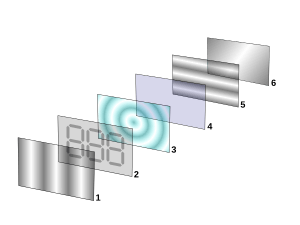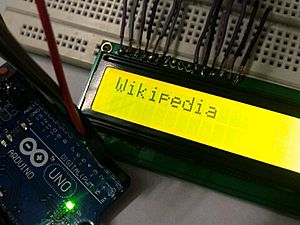Liquid crystal facts for kids
Liquid crystals are amazing substances that are usually liquid, like water, but they also have some cool features of a solid crystal. Imagine a liquid that can flow, but its tiny parts (called molecules) can also line up in a very organized way, just like in a solid.
There are many different kinds of liquid crystals, and each type acts a bit differently, especially when it comes to how they interact with light. If you look at them under a microscope with a special polarized light source, you'll see unique patterns, or textures. The picture above shows one of these patterns! The different areas in the picture show where the liquid crystal molecules are lined up in different directions. But within each area, the molecules are very neatly arranged. Just like water can be liquid, solid (ice), or gas (steam), liquid crystals can also change their form depending on the temperature.
Contents
How We Use Liquid Crystals
Liquid Crystal Displays (LCDs)
One of the most common places you'll find liquid crystals is in your TV, phone, or computer screen! These are called Liquid Crystal Displays, or LCDs. They use the special light-bending abilities of liquid crystals.
Here's how they generally work:
- A thin layer of liquid crystal sits between two special filters called polarizers. These filters are usually turned 90 degrees from each other.
- Normally, the liquid crystal twists the light that passes through the first filter, allowing it to go through the second filter. This makes the screen look clear or bright.
- When a small electric charge is applied to the liquid crystal, its molecules straighten up. This stops them from twisting the light.
- Because the light isn't twisted anymore, the second filter blocks it. This makes that part of the screen look dark or opaque.
- By turning the electricity on and off, each tiny spot (called a pixel) on the screen can switch between light and dark.
- For color screens, tiny red, green, and blue filters are added to these pixels. This lets them create all the colors you see!
Liquid Crystal Thermometers
Some special liquid crystals change color when their temperature changes. This is because their internal structure changes, which affects how they reflect light. You might have seen these on:
- Aquarium or swimming pool thermometers.
- Thermometers for babies or bathwater.
These liquid crystals are a simple way to see temperature changes just by looking at the color!
Finding Hot Spots and Stress
Liquid crystals can also change color when they are stretched or put under stress. Because of this, industries use sheets of liquid crystals to:
- Find hot spots in machines or electronics.
- See how heat flows through materials.
- Measure how stress is spread out on a surface.
- Even find tiny electrical hot spots in computer chips to fix problems.
Liquid Crystal Lenses
Imagine glasses that can change their focus automatically! Liquid crystal lenses can do this. They can bend light differently by changing the way their molecules are lined up with electricity or heat.
- These lenses can change their focal length (how much they magnify or shrink things) just by adjusting the electricity.
- They are a type of adaptive optics, meaning they can adjust themselves.
- Scientists are looking into using them for vision correction, like for people with nearsightedness or presbyopia (difficulty focusing up close as you get older). This could lead to smart glasses or contact lenses!
Liquid Crystal Lasers
Some lasers use liquid crystals inside them instead of mirrors to create the laser light. These lasers can be very small and produce a very pure color of light.
Smart Glass for Privacy
Polymer dispersed liquid crystal (PDLC) is used to make special "smart film" that you can stick on windows.
- This film can switch from being clear (transparent) to cloudy (opaque) with just a flick of a switch.
- It's a great way to get instant privacy in homes or offices!
Liquid Crystals in Everyday Life
You might be surprised to know that many common fluids are actually liquid crystals! For example, soapy water can form different liquid crystal phases depending on how much soap is mixed with the water.
Images for kids
See also
 In Spanish: Cristal líquido para niños
In Spanish: Cristal líquido para niños












